New Mexicans for
Science and Reason
Speakers and Fun
Science!
Updated 6 March 2009

While many of the NMSR web pages are devoted to
"debunking" various fringe or pseudoscientific beliefs,
NMSR also promotes fun and fascinating science for its own sake.
Many of our speakers describe their work at NMSR meetings, and
this page is devoted to descriptions of interesting research
presented to NMSR.


February 2009 Meeting: Dr. Anne H. Weaver on "The E-word: Teaching Evolution in the Land of Enchantment"
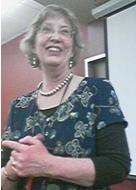
Anne H. Weaver, Ph.D. (author of The Voyage of the Beetle) spoke on "The E-word: Teaching Evolution in the Land of Enchantment." at our February 11th meeting, a celebration of Charles Darwin's 200th birthday (Feb. 12th). Starting with some recent education statistics, Anne showed that acceptance of evolution is lower in the USA than in all other developed countries, except for Turkey. Anne found that 18% of New Mexico 4th graders achieve proficiency in science compared to the national average of 27%, and that 18-19% of New Mexico 8th graders achieve proficiency in science compared to the national average of 27%. Dr. Weaver also showed that science comprehension falls markedly between 3rd and 8th grades.
When the question "What is the Scientific Method?"was asked of Santa Fe's Prospective School Board Members, the answers revealed a striking lack of science literacy:
"Ha. That's a good one. (Long pause.) The scientific method. I would guess that it would be deductive learning: being able to break it down, follow a formula." (Martin Lujan, Incumbent Board President, 8 years on School Board);
"Ok, well, the scientific method would be a method where you look for the facts, if I remember from elementary school. That's about as close as I can get to that. I haven't been to school since 1976." (Frank Montano, Incumbent)
"Any answer would be too much of a guess. I'm running for oversight and management and leadership, not professional education. That's not our mandate, as far as board members go. So you can say my answer is 'N/A.'…" (Peter Brill, running in District 5).
Anne described what factors correlate with student proficiency: monolingual cultures, societal attitudes and expectations, student self-confidence, availability of adequate resources, teacher preparation, unified curriculum aligned to clear standards, and an emphasis on principles and core ideas. As to the importance of evolution in science, Dr. Weaver cited Scott & Branch, 2008: "A teacher who tries to present biology without mentioning evolution is like a director trying to produce Hamlet without casting the prince."
Anne talked about how religious beliefs figure into the "debate," and discussed the Discovery Institute's "Wedge Strategy." The new terms being used by "Intelligent Design" advocates now include "both sides," "critical analysis," "strengths and weaknesses," "fairness," "academic theory," and Intelligent Design "theory." Anne showed that the policy of the state of New Mexico is strongly worded against allowing Intelligent design. Anne then moved beyond the question of religion to the broader question, why is creationism popular with children, even those of free-thinking or atheist families? She identified several onceptual "Sticking Points": naïve creationism, naïve essentialism, and naïve attribution of intentionality. Speaking of how children learn, she said that children's explanations for life's origins are usually one of these: creationist, spontaneous generation, or evolution. In fundamentalist communities, creationist responses predominate in every age group ; but even in in nonfundamentalist communities, the youngest children (Grades K-2) favored creation and spontaneous generation in equal numbers; the middle group (Grades 3-4) favored a creationist explanation; and the older group (Grades 5-7) and the adult group favored creation and evolution equally. Anne said the root cause was the notion of "Essentialism" - "…children …[treat] members of a category as if they have an underlying "essence" that can never be altered or removed. Essentialism … may even discourage children's learning of evolutionary theory…" (Gelman, 1999)
How can we reach these children? We need to find innovative and interesting ways to get the kids to grasp the fact that Individuals Vary; Populations Evolve. Anne described some engaging acting-out methods for teaching about variation. An audience member described a lesson in which a big bowl of candy corn mixed with M&Ms was passed around, with instructions not to eat the candy corn. After many rounds, there will still be some M&Ms -- the yellow and red ones, which camouflage well with candy corn.
NMSR thanks Anne Weaver for a splendid Darwin's Day talk. The annotated bibliography of her sources is posted on the NMSR Web Site. Check out her book, "The Voyage of the Beetle" (UNM Press).
Selected Bibliography (Annotated)
- Graph showing Acceptance of Evolution by Country: Miller, J.D., E.C. Scott, and S. Okamoto, Public Acceptance of Evolution. Science, 2006. 313 (5788): p. 765 - 766.
- Early acceptance of natural selection theory in America: Humes, E., Monkey Girl: Evolution, Education, Religion, and the Battle for America's Soul. 2007: Ecco. (p. 47)
- TIMMS Scores for 4th and 8th graders: Average Science Scores of Fourth- and Eighth-grade Students, by Country: 2007, U.S. Department of Education. National Center for Education Statistics, Editor. 2007.
http://nces.ed.gov/timss/table07_3.asp
- NAEP (Nation's Report Card) Scores for 4th and 8th graders: Student Percentages at NAEP Achievement Levels: Performance of NAEP Reporting Groups in New Mexico: 2005, U.S.D.o.E. National Center for Education Statistics, Editor. 2005.
http://nces.ed.gov/nationsreportcard/pdf/stt2005/2006467NM8.pdf
- New Mexico Standards Based Assessment Results: Change in Student Proficiency, School Years 2004-2005 to 2006-2007, Assessment and Accountability Division/Information Technology Division/NM Public Education Department. Department, Editor. 2007.
- Religious Affiliation in New Mexico: U.S. Religious Landscape Survey: Religious Affiliation: Diverse and Dynamic (PDF), PEW Forum on Relilgion and Public Life. 2008, PEW Research Center.
- Creation-Evolution Continuum: Scott, E.C., The Creation-Evolution Continuum. National Center for Science Education, 2008.
http://ncseweb.org/creationism/general/creationevolutioncontinuum/
- How Students Learn Science in the Classroom: Donovan, S.M. and J.D. Bransford, Eds., How Students Learn Science in the Classroom, Board on Behavioral, Cognitive and Sensory Sciences and Education, Behavioral and Social sciences and Education: National Research Council.
- Cognitive factors in Creation & Evolution beliefs: Evans, E.M., Cognitive and Contextual Factors in the Emergence of Diverse Belief Systems: Creation versus Evolution. Cognitive Psychology, 2001. 42: p. 217–266.
- Concept Development in Preschool Children: Gelman, S.A., Dialogue on Early Childhood Science, Mathematics, and Technology Education: A Context for Learing: Concept Development in Preschool Children, AAAS. 1999.
- Recommended Reading: Weaver, A., George Lawrence, Illustrator. The Voyage of the Beetle. 2007, Albuquerque: UNM Press.
- Further Reading: Weiner, J., The Beak of the Finch. 1995, New York: Vintage Books.

November 2007 Meeting: Dr. Gary Overturf on "The Issue of Thimerosal in Vaccine: The Science and the Hysteria"
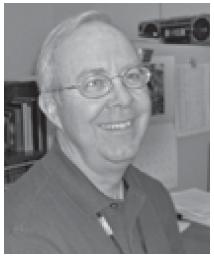
Dr. Gary Overturf is a professor of Pediatrics and Pathology at the University of New Mexico's School of Medicine. He spoke about the hysteria that has developed in some circles regarding the alleged causation of autism by mercury-based disinfectants in vaccines at NMSR's November 14th meeting.
Gary mentioned a creationist he got in an argument with over 50 years ago, in Deming, NM. "People who want to believe, will," he said. He added that the same thing is happening with today's autism/vaccine scares, and warned that some 50,000 potential lawsuits may actually end up destroying many vital health programs. Vaccinations are the Number 1 medical success story of the 20th century, he said. In the United States in the early 20th century, there were almost 200 thousand cases of diphtheria annually. In 2001, however, the number of cases in that year numbered just two. Similar successes have been obtained for smallpox, pertussis, tetanus, measles, mumps and many more diseases.
Dr. Overturf then turned to toxins in the environment. "Everything, organic and non-organic, is potentially toxic! Even water or bovine milk are toxic enough and lethal if given in high enough dose," he said. Besides dose of toxins, other key factors include variations in animal or plant species, available metabolic pathways, and the duration and routes of exposure. Mercury, for example, can be absorbed into the body by inhalation, ingestion, skin contact, via intravenous treatments, or by injections. By far the most important consideration, he said, was "Dose, Dose, Dose!!!" Toxicity is most directly related to the dose of the toxin.
Mercury can be found in both inorganic and organic forms, he said. Inorganic mercury occurs in elemental or metallic forms, or as mercurous or mercuric salts, whereas organic mercury occurs in carbon-bonded compounds such as ethyl and methyl mercury. At high doses, mercury and mercuric compounds are well established nephro-toxins (affecting kidneys) and neuro-toxins (affecting the nervous system). He said that neurodevelopmental effects have been demonstrated at low doses, but only for pre-natal exposures, not for post-natal exposures. It's difficult to perform controlled mercury-exposure experiments on humans, because we know it's indeed toxic at high doses. If metabolized, both forms of organic mercury (ethyl and methyl) affect the kidneys, whereas direct exposure to organic mercury has the most effect on the central nervous system. Mercury can inhibit protein synthesis, which is why it's a problem in kidneys.
Thimerosal, a thiosalicylate salt of ethyl mercury, is used as a disinfectant on some vaccines. It is about 50% mercury by weight, but is added to vaccines in concentrations of just 0.003% to 0.01%. An average dose of mercury as a preservative in vaccines is around 17 µg (micrograms, millionths of a gram), about as much mercury as is found in a 5 to 6-ounce can of tuna. In cases where mercury treatments on bread and rice did cause severe health problems, the exposures are on the order of 2 to 3 milligrams (thousandths of a gram) per kilogram of body weight, or about 200 milligrams (or a fifth of a gram) for a 70-kilogram adult.
Before thimerosal was removed from infants' vaccines in 2000 because of concerns for its possible effects on infants, the typical series of vaccinations given in the first six months of an infant's life resulted in a total exposure of 100 to 200 µg of mercury. Of four agencies having requirements for exposure limits, three allowed this much, with room to spare (the Agency for Toxic Substances and Disease Registry, ATSDR, under Health and Human Services (HHS) and the Center for Disease Control (CDC); the Food and Drug Administration (FDA); and the World Health Organization (WHO). While these organizations were worried about infant 6-month exposures to over 300 or 400 µg of mercury, only the Environmental Protection Agency (EPA) had a guideline of under 200 µg, specifically 106 µg. Because of EPA's concerns, thimerosal was eliminated from infant vaccines in 1999.
Something else has changed in the last few decades, and that was the very definition of autism itself. The old diagnosis of autism was expanded to include several disorders, now collectively called Autism Spectrum Disorders (ASD). There is considerable overlap between ASD and retardation; for example, Fragile X syndrome, normally the most common cause of mental retardation, is now found to also be associated with ASD. Because the definition of "autism" was expanded, the reported incidence of autism increased, and ASD is now found in about 6 individuals per thousand (or 1:166). Other diseases now associated with ASD include tuberous sclerosis, PKU, Rett syndrome, Smith-Lemili, and Opitz syndrome.
While many of the conditions related to the onset of ASD have been identified with environmental exposures to the fetus in the womb, especially in the 2nd trimester of pregnancy, no data have shown that children with ASD have increased environmental exposure to mercury. In fact, Dr. Overturf said that the incidence of autism has continued to "increase" over the last seven years, despite the removal of thimerosal in vaccines during this time interval. Only one paper, published in Lancet in 1998 by A. Wakefield et. al., supports a thimerosal/autism link, and this paper has since been retracted by the journal and all of the authors except Wakefield. Because the Wakefield study has been vigorously championed by several well-intentioned (but misguided) special interest groups, a large segment of the population (over 50% of parents surveyed) believes that thimerosal preservatives do produce autism in infants.
Several other studies have provided evidence against a relationship between thimerosal and ASD, including large studies in the United Kingdom (Andrews N. et. al. & Heron, J. et. al., Pediatrics 114, 2004, with 109,863 children studied over 1988 to 1997), California (JAMA 2001; 285:1183-1185), a CDC study on 124,720 infants (phase 1) and 16,717 children (phase 2 re-evaluation) (Verstraeten T., et. al., Pediatrics 112:1039, 2003). The latter study found "… no consistent significant associations were found between thimerosal-containing vaccines and neurodevelopmental delay." The National Academy of Science has done three detailed studies (two in 2001, and another in 2004), again showing no linkage between thimerosal and ASD.
Professor Overturf concluded by stating that in the future, some other toxin, perhaps even one with some form of mercury, may be found to be associated with higher levels of ASD; however, many thorough studies have firmly shown that thimerosal vaccines are not responsible. The "alarming" increase in autism is not due to increased exposure to toxins in the environment, but rather to the re-definition of ASD itself.
A lively Q&A session followed. Asked about radio commercials for a Santa Fe doctor claiming to have cured autism with hyperbaric oxygen therapy, Gary said the only medical application for such therapy is for scuba-diving accidents, and that there is no "magic cure" for autism, which often is associated with genetic factors.
NMSR thanks Dr. Overturf for a splendid presentation.

July 2006 Meeting: Dr. Al Zelicoff on "One Flu out of some Cuckoo's Head: Why Pandemic Influenza isn't a problem (unless you are a chicken).
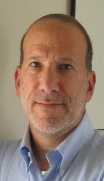
Al Zelicoff, a physicist/physician formerly at Sandia, spoke on "One Flu out of some Cuckoo's Head: Why Pandemic Influenza isn't a problem (unless you are a chicken)."
Al began by asking "What are the major international disease problems?" He identified Biological Weapons (a special problem), Pandemic influenza (not this time), and novel diseases (Hantavirus, Pertussis, Anthrax, etc.). He wondered "Why do we always get it wrong? And what can we do about it?" We gave "gotten it wrong" on numerous occasions - SARS, Monkeypox, Anthrax, Influenza shifts, and Tularemia, to name a few. And that's the ones we know about - what else is there? Why do we get it wrong? It's a combination of no data, bad science, poor statistical understanding, and failure to learn from history, Al said. He decried the lack of awareness of statistics among many medical doctors, who often generalize a few observations of a particular syndrome over their careers into "In case after case after case..."
The recent Bird Flu Pandemic Scare was officially kicked off by a cover story in Foregn Affairs magazine. With the words "The Next Pandemic" in huge red letters, the accompanying articles by Laurie Garrett got major media all excited about the imminent "pandemic." Al noted that a "pandemic" means global distribution of a disease, and not necessarily the disease's severity. Al proceeded to explain why the present threat is nothing like the 1918 Spanish Flu, which killed millions.
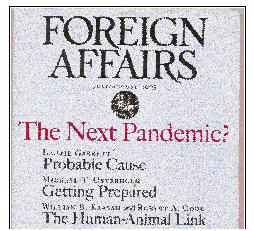
Zelicoff first described influenza nomenclature. Take the cryptic name A/ Hong Kong/ 68 (H3N2) - what do all the tags mean? For Flu, the Type is referred to by letter (A in the example), the location where identified is next (Hong Kong), followed by the year identified (68) and the "subtype" (H3N2). This last is key to understanding why the pandemic isn't what it's been cracked up to be. The "H" in the subtype refers to Hemagglutinin, a protein that binds the virus to the surface of a respiratory cell, attaching to cialic acid residues. These help the virus invade cells. The "N" stands for Neuraminidase, which cuts the bonds with H, and allows the virus to escape the cell, ready to infect another.
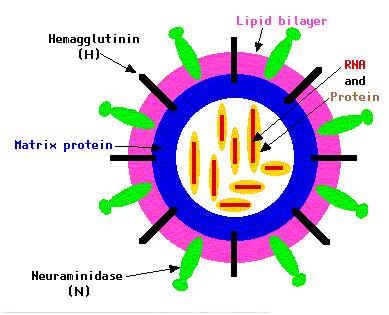
The common wisdom is that only immune system responses (antibodies) to the "H" proteins provide protection, and thus new antibodies are needed for each "H" variant. Thus, immunity to the Spanish Flu virus of 1918 (H1N1) would be useless in the presence of the new "Bird Flu" (H5N1). That common wisdom turns out to be wrong, fortunately for us! If someone has immunity to H1N1, and is exposed to H5N1, that virus will be blocked by the immune system as it tries to escape infected cells. People with antibidies for H1N1 will be protected from H5N1.
Zelicoff described Flu Pandemics over the last century. The big one, the 1918 Spanish Flu, was an extreme case, exacerbated immensely by the extremely crowded conditions in war hospitals, trenches, and so on.
In uncrowded conditions, a virus that agressively attacks and kills its host will be left alone to die before it can find a new host. Thus, uncrowded onditions favor non-aggressive strains of virus. But if conditons are very crowded, agressive strains can find an advantage: as the victim coughs his dying breaths, he can infect those next to him, and so on. Crowded conditions like the abysmal mass hospitals of World War I actually selected for more virulent and deadly strains.
Since 1918, several flu strains have impacted the world: H0N1 in 1933 (no pandemic), HxN1 in 1947 (no pandemic), H2N2 in 1957 ("Asian Flu", moderate pandemic), H3N2 in 1968 ("Hong Kong" flu, mild pandemic), and again in 1976 (Fort Dix, no pandemic). H1N1 returned in 1977 (the "Russian Flu," and was pandemic, but mainly for those under age 25 - i,e, those who had never been exposed to H1 or N1 in their lifetimes. In 1996, H5N1 ("The Bird Flu") appeared, and has not been pandemic. In 1998, H7N7 and H9N9 appeared (but no pandemic).
The threat to humans from H5N1 is small. Many have immunity by virtue of previous exposure to N1; millions have developed new immunities to H5N1 itself. The real threat of H5N1 is to chicken populations, which are held in crowded pens rivalling any of the horrors of WWI.
Because of the way chickens are often housed, for them, the Bird Flu is a serious threat indeed. But the hype about a human pandemic is extremely overblown, and detracts from truly important problems.
One reason for the "Sky is Falling" panic is that some felt we're "overdue" for a new pandemic. But looking at the actual data shows that no predictable pattern of pandemic periodicity exists. Other beliefs behind the "Bird Flu" hysteria include fears of an antigenic shift in the "H" gene, perception that there's a lack of antibodies for "H5", and insistence that antibodies to H5 are required for protection. Since some humans have gotten ill with H5N1, and since travel is widespread, we're two-thirds of the way to the pandemic, or so the story goes. Instead, immunity to H5N1 is already spreading through human populations. [On August 1st, 2006, Al sent word that "A CDC study released on Monday (8-1) 'suggests it might be more difficult for the deadly avian fly birus to spark a pandemic than originally feared.'"]
We should be scared of outbreaks of certain old (and new) diseases, Al said. We've done a miserable job on diseases which turned out to have very little impact, like SARS, but only with lots of luck (and some key observations by Dr. Bruce Tempest) was a serious outbreak of Hantavirus avoided right here in New Mexico. Then there was the case of detection of Tularemia in Washington, D.C. on Sept. 24-25, 2005. This was followed by reports of pneumonia in people who had been on the Mall in protests on those days. But, there was no surveillance, no phone calls to hospitals (nearby or out-of-state), and sloppy diagnoses. We don't have a clue what happened.
What we need, Al said, are some political and international agreements, some technological solutions, and some simple public health solutions. Monitoring is key. Al's company has developed a system, SYRIS, that is being used in Texas to create real-time communication between public health officials, private and public physicians, and (very importantly!) veterinarians. SYRIS simplifies the reporting process - it's only used on a very few patients exhibiting unusual symptoms, but when it's needed, it only takes 15 to 30 seconds for a report to be filed. SYRIS allows these data to be tracked in real time, and provides alerts to doctors if required.
Al summarized his points by stating that novel diseases are a certainty, are unpredictable, and usually associated with animals; we need better models for spreading of diseases, even common ones; international cooperation is needed; and real-time, geographic-based data collection is very much needed.
NMSR thanks Al Zelicoff for a stirring presentation.

January 2005 Meeting: Brian Sanderoff on "The Science of Polling"
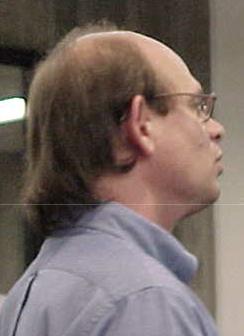
At the Jan. 12th meeting, NMSR heard Brian Sanderoff of Research and Polling, Inc., on "The Science of Polling." Sanderoff's group does polling for the Albuquerque Journal, KOAT TV7, and many other groups. Polls can cost anywhere from 8 to 15 thousand dollars, and up to 35 thousand for advanced political efforts. Research and Polling, Inc. (hereafter R&P) has about 30 full-time pollsters, and sometimes also needs external phone banks of up to 200 callers, depending on demand.
R&P does some qualitative work (like focus groups), but mainly performs quantitative polling. The latter can be done by telephone, door-to-door, by mail, or by the internet. Each method has its own pro's and con's. It's easy to generate a large, random sample with telephone surveys; high response rates can be achieved, and sampling error can be calculated precisely. The phone format allows for top-of-mind image or awareness questions also, but has its own problems (telephone poll burnout, for one). For polling about things like job satisfaction, however, self-administered mail surveys can have some advantages. Respondents can be anonymous, everyone in the Universe (e.g. the Corporation or Division, etc.) can be polled, answers can be written out leisurely and thoughtfully, issues can be ranked, written responses may be more candid, and so on. This method works best when the Universe being polled has a vested interest in the endeavor (such as a hospital's physicians). Internet polling can have very fast turnaround times at very low costs, but are less reliable because of non-random sampling bias, self-selection bias, and the representativeness of the "sample." For example, the answers to the question "Do you Google?" will be very different in an Internet poll than in a random telephone survey.
Brian explained how the "plus-or-minus" figures given for errors in polls depend not on the population size, but on the sample size instead. It's not the size of the Universe (New York City versus Rio Rancho), but the sample that counts. The basic principle is shown in the figure below.
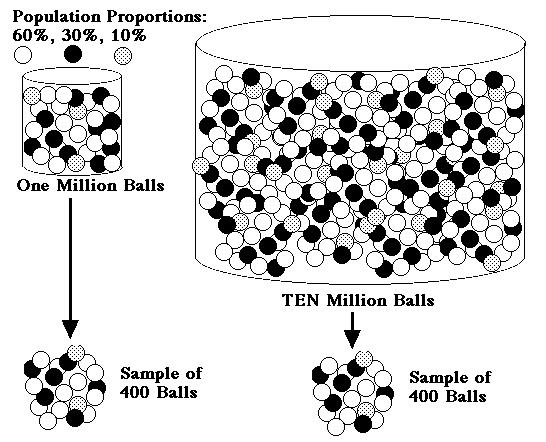
Poll accuracy depends on sample size, not on population size. If both of the two different-sized populations of colored balls above (one million versus 10 million) have the same proportions of colored balls, then samples of 400 balls drawn from either the one or the 10 million containers will be similar in proportion of colors. Using less than 400 in a sample would increase the polling error, and more than 400 would decrease it. However, the polling error in a sample of 400 is the same if that sample is from tiny little Torrance County or from the whole United States, given reasonable polling conditions.
Brian mentioned the simple formula that describes polling errors: for a 95% Confidence Interval (meaning that you get a wrong result only once out of 20 trials on average), the Standard Score is 1.96 standard deviations. For worst-case error, the expected split is 50/50 (use the last two presidential elections as examples). If the number to be sampled, N, is about 400, then the "Maximum Sampling Error" is SQRT(%For * %Against /N)*1.96 = v(0.5*0.5/400)*1.96 = about 4%. For N = 200, the error is ±7%, while for N=1000, the error is ±3%. If the decision is lopsided (say, 90%/10%, then the sampling error is reduced: for N=400, a 90% / 10% split would yield expected error of v(0.9*0.1/400)*1.96 = about 2.4%.
Brian spent a lot of time talking about polling problems, such as biases. Major biases include low response rates, under-represented demographics (like young adults with cell phones only), language, content, social stigma, respondent expectations, behavior versus attitude, and so on. There are various remedies for these biases, such as ensuring demographic quotas, multiple callbacks, and so forth. Cell phones, the Internet, and the "Do Not Call List" mindset are all changing the playing field of modern pollsters.
Sanderoff made exactly the right number of handouts (30), and predictions versus results were discussed for the recent general election in New Mexico.
In the Q&A, the importance of question preparation came up. Brian agreed that formulation of good questions was a key priority for a good poll. He also discussed "Push Polls," in which pollsters try to influence rather than test. While legitimate pollsters might ask questions like "Does X seem like an effective argument to you?", "Push" pollsters might say things like "Would you still vote for X if you knew he had a DUI? Was a child molester?"
A lively discussion ended the evening. NMSR thanks Brian Sanderoff for a fascinating discussion.

February 2004 Meeting: Professor Barbara Forrest, Darwin Day 2004
New Mexicans for Science & Reason (NMSR) hosted Professor Barbara Forrest (Southeastern Louisiana University, Department of History & Political Science ), on "Darwin Day 2004" The free meeting was held on Valentine's Day (February 14th), at the UNM Law Building, and was co-hosted by the New Mexico Academy of Science (NMAS) and the Coalition for Excellence in Science and Math Education (CESE). The meeting came two days after Darwin's actual birthday (Feb. 12th), so that our speaker could make the long trip from Louisiana over the weekend.
Barbara began by saying she was speaking to us as citizens, a role which unites all of us regardless of profession. By "we," she said, she meant citizens concerned with protecting public science education and church-state separation, those who value civic friendship instead of divisive religious politics, and those who regard secular, constitutional democracy as the protector of, not an obstacle to, personal religious freedom in whatever form chosen to exercise it. "We are people who will work hard to protect personal religious freedom, but will work just as hard to keep personal religious preferences from becoming public policy," she said, adding that Intelligent Design (ID) is very much a religious and political movement, and that its proponents are working to get their personal religious preferences enacted as public policy in the nation's schools. Barbara said this goal is called "teaching the controversy."
To explain why the discussion of ID needs to take a new direction, Prof. Forrest reviewed what the ID movement has not done, and also what they are doing. What they have not done, she said, was science. "The ID movement has produced no science in the twelve years since the Wedge's coalescence. Qualified scholars and working scientists -who have produced the science that Wedge scientists have never done-- have critiqued ID and amply demonstrated that it is not science. Indeed, the ID movement is not truly about science. Phillip Johnson confirmed this as early as 1996, when the ID movement formally organized as the Center for the Renewal of Science and Culture: 'This isn't really, and never has been, a debate about science. It's about religion and philosophy.' Johnson cites the Gospel of John as the biblical foundation of intelligent design."
Barbara also said that ID creationists demand equal consideration for ID as an "alternative theory" in the name of "fairness, but that "fair" does not necessarily mean "equal." And, she said, their demand ignores the point that teaching children real science is fair, whereas allowing them to be pressed into the service of the Discovery Institute's religious/political agenda is not. Forrest said we must therefore keep one spotlight focused on the fact that, after twelve years, ID is a scientific failure.
Prof. Forest discussed the underpinnings of ID "science" (irreducible complexity, empirical detection of ID, etc.), and also the leaders of this political movement (Phillip Johnson, William Dembski, Michael Behe, Jonathan Wells, and others from Seattle's Discovery Institute). She discussed the ID onslaught on school boards, and the use of clever buzzwords like "teach the controversy," "teach strengths and weaknesses," "teach objective origins," "teach the alternatives," "teach critical thinking," "academic freedom," and so on, all used to disguise ID's actual creationist foundation. Barbara discussed recent ID activity in Darby, Montana, and said that while ID creationists have always lost big, they spin everything as a victory and press ahead with their agenda anyway.
Prof. Forest discussed the underpinnings of ID "science" (irreducible complexity, empirical detection of ID, etc.), and also the leaders of this political movement (Phillip Johnson, William Dembski, Michael Behe, Jonathan Wells, and others from Seattle's Discovery Institute). She discussed the ID onslaught on school boards, and the use of clever buzzwords like "teach the controversy," "teach strengths and weaknesses," "teach objective origins," "teach the alternatives," "teach critical thinking," "academic freedom," and so on, all used to disguise ID's actual creationist foundation. Barbara discussed recent ID activity in Darby, Montana, and said that while ID creationists have always lost big, they spin everything as a victory and press ahead with their agenda anyway.
Barbara made a special point to forestall any thought that her position is anti-religious. "ID creationists constantly charge that if one is pro-evolution, one is also anti-religion, or that if one is for secular democracy and education, one is automatically against religion. This is a misconception of the word secular, she said. Many evangelical leaders are shifting toward the idea that "secular" means "anti-religious." "In their view, if an institution such as government or an academic discipline such as science does not explicitly incorporate religious belief, that institution must be understood as overtly hostile to religion. In short, secularism is rejected by people who want their religious beliefs sanctioned as public policy. But secular means non-religious, not anti-religious. Secularism is a political concept vital to constitutional democracy, and we must rehabilitate the concept as such in the public mind," she said, adding "The ID agenda is an anti-secular movement. It is another column in the Religious Right."
Barbara gave many examples of the religious underpinnings of the ID movement, including groups like Friends of the Family, the Eagle Foundation, and others. ID is one of many fronts in a "culture war" that is being waged by Religious Right fundamentalists. She stressed the exclusionary nature of the religious outlook of many ID leaders; for example, Phillip Johnson demonstrated ID's religious exclusionism by slandering the religious faith of Catholic evolutionary biologist Kenneth Miller: Johnson said "The only reason I have to believe that Kenneth Miller is a Christian of any kind of that he says so. Maybe he's sincere. But I don't know that. If he is, I can say this: you often find the greatest enemies of Christ in the church, even in high positions. There is a kind of person who may be sincere in a way, but is double-minded, who goes into the church in order to save it from itself by bringing it into concert with evolutionary naturalism, for example. And these are dangerous people. They're more dangerous than an outside atheist, like Richard Dawkins, who at least flies his own flag. So I am not impressed that somebody says that he is a Christian of a traditional sort and believes that evolution is our creator. This is, at the very least, a person whose mind is going in two directions, and such people often do a great a damage within the church."
In effect, the ID movement wants their strict, narrow view of God, as one who would never stoop to using evolution, to be mandated as official government policy. This is patently unfair - not just to atheists and agnostics, but also to the many religious people who believe evolution was simply God's method of creation. Barbara mentioned several intellectual believers who have found delight in reconciling their views of science and religion, such as evangelical Christian Keith Miller's new book, "Perspectives on an Evolving Creation." Barbara stressed that there need not be the type of conflict that ID is creating.
Prof. Forrest said that ID proponents are our fellow citizens, and under the Constitution they are entitled to their exclusionary religious views and their dislike of secularism. But, she said, they are not entitled to have those views enshrined as public policy.
Barbara concluded by reflecting on the long and successful marriage of Charles and ??? Darwin, and wishing everyone a Happy Darwin Day and Happy Valentine's Day. She closed with this, from Darwin's "The Descent of Man" : "Females . . . prefer pairing with the most ornamented males, or those which are the best songsters, or play the best antics; but it is obviously probable that they would at the same time prefer the more vigorous and lively males, and this has in some cases been confirmed by actual observation."

March 2003 Meeting: The
Sci-Fi Channel Roswell Dig
New Mexicans for Science & Reason (NMSR) heard Dr. William
Doleman (UNM, Office of Contract Archaeology) speak on "The Sci-Fi
Channel Roswell Dig." The meeting was held on March 12th, 2003, in
the NM Museum of Natural History and Science. Doleman was prominently
featured on the Sci Fi Channel's November 22nd, 2002 airing of the
documentary "The Roswell Crash: Startling New Evidence," hosted by
Bryant Gumbel. (See the March/April 2003 edition of Skeptical
Inquirer for Dave Thomas's review of the Sci Fi show.)
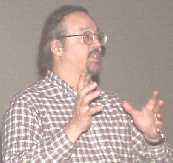
Bill Doleman (Photo by Dave Thomas, copyright 2003)
Doleman said he was a bartender and a free-lance writer before
becoming interested in archaeology. His field, contract archaeology,
accounts for 90% of all money spent on archaeological work. Many of
the contracts involve federal mandates such as the Historic
Preservation Act of 1966. Contract archaeologists study the cultural
impacts of land development or government projects by determining if
the land has any sites that might qualify to be on the National
Register. Candidate sites may qualify based on location (such as
battlefields), persons who lived there (Washington's home), crafts
(such as pottery) or significance with regard to history or
prehistory. Doleman mentioned Kennewick Man as an example of a
far-fetched claim (namely that this man from many millennia ago is
ancestral to Native Americans now living in the same area). UNM's
Office of Contract Archeology (OCA) competes with several private
outfits for contracts for what are essentially cultural equivalents
of environmental impact statements.
In 1999, Doleman's group was approached by UFO researchers Don
Schmitt and Tom Carey, and was asked how he would study a "UFO" site.
Doleman laid out a budget for a small project, but it cost too much,
and he didn't hear from Schmitt and Carey again for three years.
Then, in 2002, they returned, this time with backing from the Sci Fi
Channel. Doleman met with Larry Landsman, the Sci Fi Channel special
projects director, and prepared a budget and test plan. The crew
began field work at the purported Roswell crash site on September
16th, 2002, and stayed about 9 days. Attendee Ken Frazier asked if
there had been discussion within UNM about being connected to
"paranormal crap," but Doleman said there was nary a peep of discord
until much later, when Target 7's Larry Barker began asking UNM
officials about the OCA's involvement with the Sci Fi show. Doleman
said he wasn't there that night to defend what the Sci Fi Channel
did.
His team's goals were: o search for evidence of a low-angle impact
by .. something; o use reported (anecdotal) observations to decide
where to perform the search; o survey the site for debris, or a
"furrow" or "gouge." The show advisors, Schmitt and Carey, chose the
location for the "Roswell Dig." Doleman said author Kevin Randle also
approved the location for the site. Doleman said the rationale for
doing the dig was that they had a Contract. The Roswell "Incident" is
culturally and economically important, both in New Mexico and
world-wide. He said the bigshots at UNM said the work was
appropriate.
Doleman said the incident should really be called the "Corona
Incident," but that Corona didn't have a sheriff, and so Roswell got
all the fame. But, until now, there hasn't been a search for real
physical evidence. He said Schmitt and Carey were brave to put their
ideas to the test. Two million people watched the show, and a sequel
is planned, he said. For now, everyone's happy, Doleman said- Schmitt
and Carey stay on the world's radar, MPH Entertainment gets a nice
gold star, and UNM'S OCA gets paid.
Doleman talked a bit about archaeology as the forensic science of
the past. Clues in sites today can tell archaeologists much about the
past, such as whether the original inhabitants used stone boiling or
pit roasting. The processes that shape sites can be divided into
cultural (C-transforms) and natural (N-transforms). Had they found
the remains of an Air Force balloon experiment, that would have been
a C-transform.
What were the results of the Roswell Dig? Doleman said they were
"more than I expected, less than they [Sci Fi Channel] hoped
for." From aerial photographs, pre- and post-1947: there was no
furrow. In the electromagnetic conductivity survey, there was no
furrow. From the High-resolution Metal Detection Survey: no obvious
debris. From Archaeological Testing (pits, soil samples, etc.), there
was no obvious debris, 25 HMOU's (Historic Materials of Uncertain
Origin), and 66 soil samples. Backhoe trenching provided one anomaly,
a V-shaped feature that might have been a "furrow," but that mostly
disappeared when scraped. Doleman said he's written this off "about
95%" now, but still.... There was also a soil stratigraphy study. An
"alternative furrow" was found, but interest in this fizzled when it
turned up on 1946 aerial photographs (from a year before the Roswell
Incident). They also found a beat up old weather balloon, but one
only ten or so years old, not fifty.
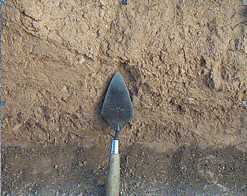
The "Furrow" (photograph courtesy & copyright 2003
William Doleman)
A lively question and answer session followed the talk. NMSR
thanks Bill Doleman for an informative lecture.
See Also: Bait and Switch
on 'Roswell: The Smoking Gun’

January 2003 Meeting:
Molecular Evolution
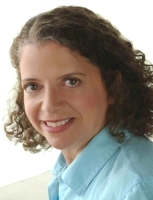
New Mexicans for Science & Reason heard Dr. Rebecca Reiss (New
Mexico Tech) on " Molecular Evolution: Studies in Microbes, Middens,
and Man" at our January 11th meeting. Rebecca began by discussing her
work on xenobiotics -- bacteria that can metabolize exotic compounds
like the dangerous pollutants called dihalogens, which include
ethylene dibromide (EDB) and ethylene dichloride (EDC). Reiss
mentioned there are 175 sites with such pollutants in New Mexico,
described with the acronym LUST - Leaky Underground Storage Tanks. In
Reiss's pilot project, levels of EDB and EDC have been monitored at
selected LUST sites in New Mexico, and the levels of these compounds
have been seen to decrease over time. The best explanation is that
it's biotic - bacteria are breaking down these dangerous compounds,
and performing a valuable public service. But the rates are quite
slow. How can science speed up this process?
That's where the two fields of genomics and proteomics comes in.
Genomics is the study of DNA, the genetic material, and its RNA
products. RNA, in turn, directs the assemblies of legions of amino
acids into long chains called proteins, which are the molecules of
both structure (like bone) and activity (like enzymes for digestion).
The study of how the amino acid chains fold up and interact with
other molecules is called proteomics. So, the question of
understanding bioremediation of such compounds involves identifying
the particular species involved (and many species of bacteria are
lurking there), isolating the responsible genes, or isolating the
actual proteins. Rebecca discussed PCR (polymerase chain reaction),
which can be used to "amplify" tiny snippets of DNA into measurable
amounts. This technique is very useful, but it has its pitfalls - for
example, any contamination (DNA from, say, a human handler) can also
be amplified to yield a false signal. Reiss's group has studied using
16SrRNA primers to isolate the xenobiotic genes of the
dihalogen-consuming bacteria. Another approach is to study the
proteins directly, but proteins can't be amplified like genes can
with PCR. But, you can examine banded protein stains from pools of
hundreds of bacteria, and perhaps even deduce the key proteins for
the reaction. If you can, then duplication of the proteins in mass is
quite practical. Also, the amino acid sequence can be converted into
a DNA sequence, and appropriate DNA primers can be developed, which
will lock onto the corresponding genes in the bacterial genomes.
Besides the impressive biology, there are many difficult technical
issues involved, such as filtering bacteria from solution, growing
bacteria that refuse to be cultured, asnd so forth.
Rebecca also discussed work with middens (dung heaps near houses),
and how molecular markers could assist with archaeological studies.
She mentioned her work on human evolution and NUMTS
(Nuclear-localized mitochondrial DNA's). Our cells have many
mitochondria outside the nucleus, busy helping us get enough energy.
But, occasionally the DNA from one of these energy powerhouses (which
probably were a stand-alone microbe before their assimilation long
ago into our eukaryotic cells) can migrate right into the nucleus,
where its rate of mutation/evolution slows down. When we compare our
DNA with that of other humans, or other primates, we can observe many
different NUMTS, because this migration process is still ongoing.
NUMTS can be used in forensic analysis; there are so many that
comparison of several can indicate how closely related given test DNA
is to that of an individual or group.
NMSR thanks Rebecca Reiss for a delightful presentation.

November 2002
Meeting: Structure of the Universe
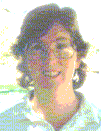 Trish Henning
Trish Henning
New Mexicans for Science & Reason heard Associate Professor
Trish Henning (UNM, Director, Institute for Astrophysics) on "The
Structure of the Universe." The meeting was on November 13th. Trish
started by mentioning the distribution of mass. Where is it? What is
the difference between luminous mass and so-called "dark matter"? We
can see nearby galaxies (Andromeda in the northern hemisphere, the
Magellanic Clouds in the southern), and in the last few decades, we
have learned quite a bit about the distribution of galaxies through
the universe. One of the big surprises was the discovery of the local
super-cluster about 50 years ago. Since then, better and broader
surveys have been performed, revealing huge voids between clusters of
galaxies.
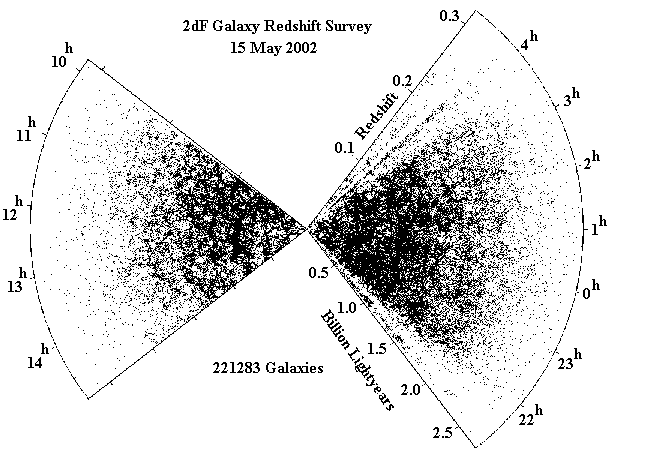
From the 2dF Galaxy Redshift Survey, showing voids and
structure over billions of light years
Trish talked about how the expansion of the universe is used to
estimate position of galaxies from observed speed, which is given by
the Doppler shift of galactic emissions. Because gravitational
interactions can act against the motion of expansion (locally, at
least), clusters of galaxies tend to get smeared out in Doppler-shift
plots. Trish talked about the difficulty of seeing galaxies through
the disc of the Milky Way, and how radiotelescopes use the hydrogen
21-cm line to penetrate galactic dust. She talked about ongoing
galactic surveys, including the one she works on in Australia, and
New Mexico's Sloan Digital Sky Survey. It looks like we're finally
able to discern the scale of galactic clustering across the
universe.
NMSR thanks Trish Henning for a delightful presentation.

October 2002 Meeting:
Panel Discussion on the "Language Gene"
New Mexicans for Science & Reason heard a Panel Discussion
featuring Distinguished Biology Professor Randy Thornhill (UNM),
Retired Linguistics Professor Hank Beechhold, and Anthropologist Ted
Cloak, on Implications of a New-Found "Language Gene" (re Svante
Paabo's and colleagues' research on FOXP2). The October 9th meeting
got started with a brief introduction by Dave Thomas. It all begins
with an extended family (the KE family), half the members of which
exhibit a severe hereditary language disorder. The disorder involves
unintelligibility, trouble forming plurals, and more, and even shows
up in physical brain scans. From genetic studies of family members, a
gene, FOXP2, was found to be the likely culprit of this language
disorder. Later, Paabo's team compared FOXP2 of unaffected humans and
several other primates, and found that the normal human form of FOXP2
was different from that of chimps and the other apes, and other
mammals as well. Earlier this year, FOXP2 was heralded as a "Language
Gene" distinguishing man from the apes.
The first panelist, biologist Randy Thornhill of UNM, stressed
that neither genes nor environment alone determine the development of
traits, but rather the interaction of the two (the Interactionist
Perspective). Both environmental determinism and genetic determinism
have been tossed on the trash heap, he said. Evidence supports the
now accepted Interactionist model, and so one can't consider any
given trait as more environmental than genetic, and vice-versa.
Language has important social causes, like learning, but it also has
physical aspects involving muscles, vocal cords, and so forth. There
was no question genes were involved before FOXP2's discovery, Randy
said, it's that we didn't know which of the tens of thousands of
genes affected language. And many genes are involved. The interesting
question is not whether or not language is biological, Randy said; we
knew that already! It is not whether evolution did it, but which
evolutionary process did it. It could have involved direct selection
for the trait or traits, or indirect ("coat-tails") selection.
Genetic drift is out as an explanation because language is much too
complicated. Language shows design, the hallmark of adaptation. It
can be used to communicate, to deceive, or to manipulate. Because
language involves multiple adaptations, Randy said, it clearly isn't
due to indirect selection. Language is directly selected. We pay
attention to it; it has become a Fitness Indicator. Randy mentioned
his work on symmetry, and his view that facial and body symmetries
are likewise fitness indicators. (This was the topic of our June 1997
meeting, and is reported in the July 1997 NMSR Reports). Thornhill
also spoke to NMSR on biology and rape at our May 2000 meeting (June
2000 NMSR Reports).
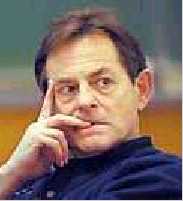 Biologist Randy Thornhill
Biologist Randy Thornhill
Panelist Hank Beechhold, a retired professor of linguistics, spoke
about the origin of language. We don't know what form the first
language took, he said. Some have speculated it developed from
imitating animal sounds ("Bow-Wow Theory"), other sounds (:Ding-Dong
Theory"), or perhaps grunts. Language is related to consciousness
itself, Hank said, and consciousness itself is related to language.
Hank's second point was that "language" is much harder to define than
most people think. Communication? Even single-celled creatures
communicate with their environment. Is language merely "A means of
phonetic communication shared by groups of humans?" What then of
writing, or signing? No, speech is simply one medium or channel, not
language itself. Therefore, Hank said, language precedes speech, as
competence precedes performance. While FOXP2 does affect speech, Hank
said, there are undoubtedly many other genes involved. Hank mentioned
an African gray parrot studied by Pepperberg, who found the bird able
to actually communicate verbally at the level of a young child. It
would be foolish to lay all language at the feet of FOXP2, but it's a
player. Perhaps it was selected for some property like facial
expressions after language and speech had appeared. Hank concluded by
mentioning that adult Neanderthals had vocal tracts like those of
young infants, and that their ability to articulate speech would have
been quite limited. Was this related to Neanderthal extinction? Did
Neanderthals have FOXP2? Is FOXP2 related to speech, or to language?
(At this point, it was suggested that we might try to get some
Neanderthal DNA and check it for FOXP2 differences.)
 Linguistics professor Hank Beechhold
Linguistics professor Hank Beechhold
The final panelist, anthropologist Ted Cloak, commented that the
panel was turning out to be more of a love feast than a hotbed of
controversy. Like the other two speakers, Ted said FOXP2 is a
language gene, but not the "language gene." Ted described the KE
family, and the nature of their language disorders. One problem they
have is generalizing about number, gender, or sex. For example, some
words are easy to pluralize (dog, dogs), but others have special
rules (sheep, sheep, or cow, cattle). The affected members of the KE
family see every pluralization as a "special" case. They have to
learn that dogs are the plural of dog, and also, that cats are the
plural of cat, and so on for all nouns.
(At this point, someone suggested that people who had trouble with
tenses or plurals, or maybe even those who say "nuke-u-lar," might
soon be described as "FOXP2 challenged.") Ted discussed how the gene
might have been changed by a selective sweep and fixation event, but
that this hasn't been proved yet. What would happen if the chimp
FOXP2 was somehow injected into a human? It wouldn't necessarily be
the same as what happens in the KE family, because their genetic
defect is a mutation of the working human gene, and might not be
"chimp-like" at all. Of course, we can't put chimp DNA into a human
child, so we'll have to figure it out some other way. Ted again
emphasized that FOXP2 may be a player, but it's not the only one.
Language is not a necessary precursor to culture; it arises as
enhancements of culture. One of the first critical human capabilities
was fine imitation. Ted's conclusion was that culture most likely
preceded language, not the other way around.
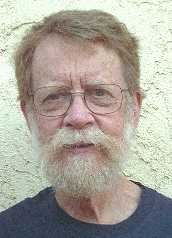
NMSR thanks panelists Thornhill, Beechhold, and Cloak for a most
interesting discussion.

March 2002 Meeting: Cody
Polston & Bob Carter on Ghost Hunting
by Dave Thomas : nmsrdaveATswcp.com
(Help fight SPAM! Please replace the AT with
an @ )
New Mexicans for Science & Reason (NMSR) heard Cody Polston
and Bob Carter of the Southwest Ghost Hunters Association (www.sgha.net)
speaking on "Hunting for Ghosts" on March 13th, 2002.

Cody Polston
Bob Carter kicked the evening off by saying that the SWGA group is
interested in finding out what causes ghostly visions, even if there
is a prosaic explanation. One of the possibilities they are looking
at is that visions of specters might be caused by abnormal
electromagnetic fields, as has been hypothesized by Michael
Persinger. Cody Polston noted that photographs alone cannot prove
ghostly visitations, and that even negatives can be faked. Cody
mentioned that the group's bylaws prevent them from using psychics in
their investigations, as you cannot use one paranormal phenomenon to
validate another. This attitude has earned SWGA criticism from other
ghost groups, which routinely employ psychics in their
investigations. He described a curious incident they investigated in
Texas, where cars left parked on a train track are mysteriously
"pushed" out of harm's way, with small handprints visible in flour
particles dusted onto the rear of the car. However, it's a gravity
hill, and the motion of the car is no real surprise. Furthermore, the
group found that when the flour is put on the car, it reveals
handprints that were already there, made visible because of oils and
residue left behind. This did not make them popular with the Texas
ghost group.
The group does "investigations" once or twice a month, and employs
some low-tech magnetic field sensors to look for odd fields. They
typically measure from 5 to 40 Hertz only. Cody and Bob described
some of the curious events they have observed, such as glasses
blowing up at Maria Theresa's restaurant, flashing lights at La
Placita, weird knocking at the Church Street Café in Santa Fe,
and sliding chairs at Los Ranchos de Corrales restaurant. Cody noted
that even if the group could prove that photographed "orbs" were real
phenomena, it's still a big leap to prove they are ghosts.
All in all, it was a friendly encounter. Cody and Bob do think
there may be something to ghost stories, and that's what keeps them
going. But, they don't declare that every fuzzy blob in photographs
is a "ghost," either. The group could use help with basic
electromagnetics and ideas for sensors, if anyone wants to help out.
Their investigations are open to those who want to tag along.
NMSR thanks Cody and Bob for an interesting talk.

February 2002 Meeting:
Stuart Kauffman on Investigations
by Dave Thomas
New Mexicans for Science & Reason (NMSR) heard Stuart Kauffman
of the Santa Fe Institute and BiosGroup speaking on "Investigations"
on February 13th, 2002.
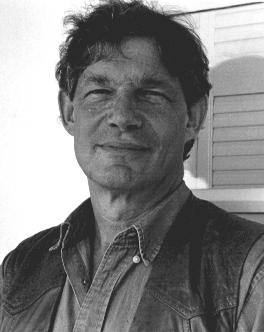
Kauffman is a biologist and former professor of biochemistry at
the University of Pennsylvania and a professor at the Santa Fe
Institute; author of Origins of Order: Self Organization and
Selection in Evolution (1993), and coauthor with George Johnson
of At Home in the Universe (1995). He talked to NMSR about his
third book, Investigations.
Kauffman began by introducing the concept of "autonomous agent."
Is a bacterium, which could be said to act on its own behalf as it
gleans food from its environment, an autonomous agent? Stuart then
gave his definition of such an agent: "A self-reproducing system that
can do one thermodynamic work cycle." He raised and lowered a pen,
illustrating a work cycle, and thus demonstrated his own status as an
autonomous agent. The bacterium is also such an agent, of course. But
something that reproduces without work, such as a crystal, isn't an
autonomous agent. Even DNA is not an autonomous agent; it specifies
order, but does not perform work cycles. Kauffman mentioned that
Schrödinger predicted that life would require aperiodic crystals
bearing a code nine years before the elucidation of the structure of
DNA by Watson and Crick. Stuart said the question of what makes a
cell alive is still open.
One of the perplexing problems of the origin of life (not to be
confused with the subsequent evolution of diverse life forms over
billions of years) is that DNA codes for proteins (strings of amino
acids), but proteins are required to help copy the DNA. As yet, we
haven't been able to make a molecule that makes copies of itself
without the assistance of other molecules like proteins. It's hard to
get RNA (ribonucleic acid) to duplicate itself, because too many G's
and C's (guanine and cytosine nucleotides) make it fold up in knots.
But it's probably not impossible, Kauffman said. He mentioned
Gunter's research on a "cousin" of RNA, in which hexamers made copies
of themselves without other proteins to assist. Stuart also mentioned
work on a 32-amino-acid protein that breaks into smaller subunits (of
15 and 17 amino acids each), and how the subunits catalyzed the
production of more copies of the 32-amino-acid sequence. He said this
self-reproducing protein "blew the field wide open."
He went on to discuss systems in which components catalyze each
other, but not themselves. If two molecules A and B can catalyze each
other's formation, as has been demonstrated, why can't three? Or
four? Or hundreds or thousands? Kauffman called such assemblages
"autocatalytic systems." He talked about a button-and-thread model
for self-organization, in which buttons and threads are strewn on a
floor. Pairs of buttons are connected with the threads randomly. At
first, most of the buttons are free; there are a few pairs, and even
some triplets. But as more threads are added to given pairs, the
number of interconnections rises steeply. Larger clusters are joined
into still larger clusters, until BAM! - giant clusters are
formed.
Kauffman then introduced the concept of "adjacent possible." If
you have a bunch of molecules and reactions, what collection of
molecules will exist after one reaction step? There are many
possibilities, which constitute the immediate "adjacent possible."
For example, once there were just a few organic molecules; but now,
there are trillions. "The biosphere has expanded into its adjacent
possible," Kauffman said. Additionally, the number of ways to make a
living has exploded.
Stuart then discussed work cycles and energy. Work cycles are a
way to link spontaneous and non-spontaneous reactions. For example,
the hexamer (6-acid molecule) which catalyzes pairs of trimers
(3-acid molecules) to form more hexamers performs work cycles. It
"eats" energy (supplied as photons of light) and trimers, and
produces more hexamers like itself. The process can oscillate back
and forth, respond to feedback, and so on. Kauffman criticized the
standard definition of work as force times distance, and says he
prefers to define work as "the constrained release of energy." But
where do the constraints come from? Who makes the pistons in Carnot
engines? It takes work to make the constraints, and it takes the
constraints to produce work. Work can be non-propagating, like
shooting a cannonball into a field; while a hole and hot dirt are
created, no useful work is performed. But arrange the cannonball to
turn a paddle wheel as it zooms away, and that can be harnessed to,
say, pump water and irrigate the fields. This is "propagating" work,
he said.
In cells, the cells make lipids of different types that combine in
layers, producing vital cell membranes; these are the "constraints"
of the cell. And the cell makes copies of itself, providing closure.
Kauffman said it's not just a question of matter, energy, or Shannon
information: it is an organized system that propagates itself, a
"living" state of matter and energy.
Unlike physics, in which the "adjacent possible" states of, say,
atoms in a sealed vessel can be easily described, the biosphere is
not finitely pre-describable. As an example, Kauffman discussed
Darwinian pre-adaptations. We all have hearts, needed for pumping
blood. But what if the heart could have another as-yet-unanticipated
function? What if some one person's heart happened to be sensitive to
vibrations typical of impending earthquakes, and that this ability
caused the person to run to safety outside just before massive
earthquales can strike? That person might have more descendants than
others without sensitive hearts, and if there were many earthquakes,
that ability might spread to many descendants. We can't possibly
anticipate all the possible pre-adaptations, and so we can't even
define the "adjacent possible." Stuart suggested that a possible "4th
Law of Thermodynamics" for the biosphere is that it will expand into
the adjacent possible as fast as it can get away with it. But
Kauffman hasn't figured out how to mathematize it, because he can't
even list all the possibilities.
A lively question and answer period followed the donut break. In
response to one question, Kauffman cautioned that we don't really
know for sure what will happen because of genetically modified foods,
because we don't know for sure how those genes will interact with
others in the field. Paul Gammill asked about teaching "Intelligent
Design" in schools. Kauffman replied that design theorists have not
made their case to biologists, and don't deserve equal time in
schools, because the fact of evolution appears to be
incontrovertible. Gammill proceeded with a laundry list of questions
regarding chirality, complexity, and so forth. Kauffman said these
questions included some very good ones, and he provided some good
answers and areas for exploration. He said the Design Theorists need
to identify their Designer if they expect to develop their theory as
a science.
Stuart Kauffman concluded with a brief discussion of Maxwell's
Demon, a hypothetical construct that could appear to violate the laws
of thermodynamics by, say, allowing only atoms of a certain speed to
go though a hole connecting separate containers, thus changing the
state into one of disequilibrium. While no Demon can exist in the
domain of atoms alone, it's different in the biosphere. There,
Darwinian pre-adaptations can be "measured" by the biosphere (much as
the Demon would measure an atom's speed), and adaptations that are
favored in the environment can be "catalyzed." He concluded that "The
biosphere keeps finding new ways to measure displacements from
equilibrium, and how to get work from them."
NMSR thanks Stuart Kauffman for a mind-expanding talk!

November 2001 Meeting:
An Insight Into Relativity
by John Geohegan
Einstein's Special Theory of Relativity (SRT) is generally
misunderstood for several reasons. Most of us have no need to apply
its principles, nor do we have any experience with objects moving at
close to the speed of light. Even so, we would like to understand
SRT. Popular explanations refer to moving objects gaining mass and
shrinking in the direction of motion, and moving clocks running slow,
but these explanations are referring only to appearances in much the
same manner as statements about the sun rising in the morning, moving
eastward across the sky, and setting in the evening. We accept that
the sun appears to rise in the morning and we can calculate exactly
when the "rise" will occur, but a more accurate and lengthier
statement would deny that the sun truly rises and explain the
appearance by referring to the rotation of the earth.
Just as the formulas for calculating the sun's apparent motion are
likely to contribute nothing to understanding the reason for the
appearances, applying the formulas of SRT really doesn't reveal why
objects appear to contract and clocks appear to run slow. It's
perfectly possible to apply the set of relativistic equations called
the Lorentz transformation and obtain a correct numerical answer
without having a clue as to why the equations work so well. This is
number-crunching without insight.
The following example offers a simple way of gaining insight in
relativity.
Imagine two space ships have just passed each other and at the
moment of closest approach they have synchronized their clocks at
12:00. As they draw farther apart each sends out a flash of light
precisely as his own clock indicates each hour. Brian will receive
Alfred's 12:00 signal when his clock reads 12:00 because the signal
has no distance to travel, but Alfred's 1:00 signal will be received
at some time later than 1:00 depending on their relative velocity. To
make things easy, suppose the velocity is great enough that Brian
receives Alfred's hourly signals every two hours by his (Brian's)
clock. SRT tells us that the same conditions will apply to Alfred; he
will receive Brian's clock signals every two hours, at 12:00, 2:00,
and 4:00 by his (Alfred's) clock.
Consider the signal sent out by Alfred at 1:00. It is received by
Brian when his clock reads 2:00 and reflected back at the same time
to be received by Alfred when his (Alfred's) clock reads 4:00. Not
being able to see Brian's clock, Alfred calculates that the signal
must have reached Brian at 2:30 (halfway between 1:00 and 4:00). If
informed that Brian's clock actually read 2:00, Alfred might conclude
that it was a half-hour slow, and thus we see what it was that
Einstein discovered: measurements of time intervals depend upon
relative velocity. Of course, if Brian sends out a signal when his
clock reads 1:00, exactly the same values will be repeated and he
will see that Alfred's clock is apparently running slow. Without the
insight made possible by this simple example it's possible to
misinterpret SRT as claiming that A's clock is running slower than
B's at the same time as B's is running slower than A's.
The same example, slightly extended, can be used to explain the so
called "twin paradox", which is not a paradox at all. If after
traveling for two hours by his clock, Brian were to suddenly change
to a return trip at the same relative velocity, he would start
receiving signals at the rate of two per hour instead of one every
two hours. On his two hour return home he would thus receive four
more signals sent out by Alfred, arriving home just as Alfred was
sending his 5:00 signal. Alfred would have aged five hours while
Brian aged only four. This problem illustrates the relativistic
nature of time intervals.
It must not be thought that SRT deals only with some sort of
illusion. Einstein's theory unified electricity and magnetism and is
tested every day for meaningful predictions. The Global Positioning
System tests Einstein's predictions millions of times each day,
worldwide, and reveals the magnificence and practicality of
relativistic calculations.

The following images, by Dave Thomas, show how Doppler
measurements of the binary stars in system Castor C (in the
constellation Gemini) agree with Einstein's theory (speed of
light is constant invacuum), but do NOT agree with the
predictions of theories in which the speed of light depends on the
speed of the light-emitting source.
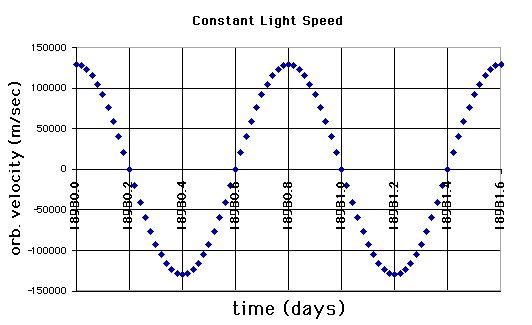
Expected Time/Velocity Curve of One Star of Castor C (Binary
System), if Einstein was RIGHT (Light travels at 299,792,458
meters/sec)

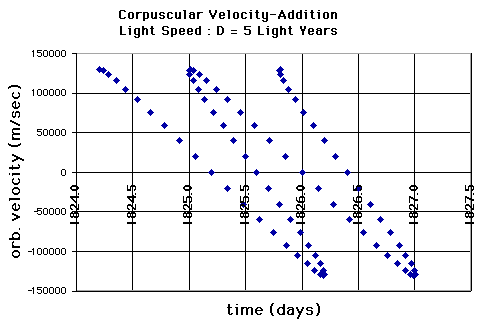
Expected Time/Velocity Curve of One Star of Castor C (Binary
System), if Einstein was WRONG (Light travels at c=299,792,458 m/sec
± motion of source);
here, Castor C is 5 light-years away. At orbital speeds of 0.0004c,
transit times will vary from 5 lightyears/(1-.0004 )lightyears/year =
5.002 years = 1827.0 days,to 5 lightyears/(1+.0004)lightyears/year =
4.998 years = 1825.5 days, or about 1+1/2 days.

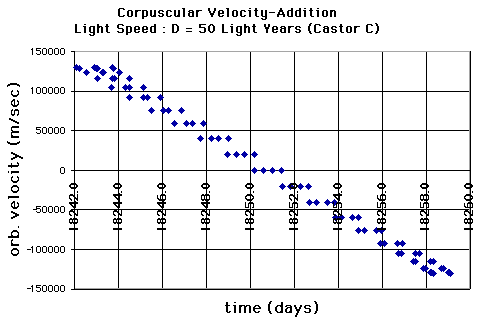
Expected Time/Velocity Curve of One Star of Castor C (Binary
System), if Einstein was WRONG (Light travels at c=299,792,458 m/sec
± motion of source);
here, Castor C is 50 light-years away (about actual). At orbital
speeds of 0.0004c, transit times will vary from 50
lightyears/(1-.0004 )lightyears/year = 50.02 years = 18270 days,to 50
lightyears/(1+.0004)lightyears/year = 49.98 years = 18255 days, or
about 15 days.

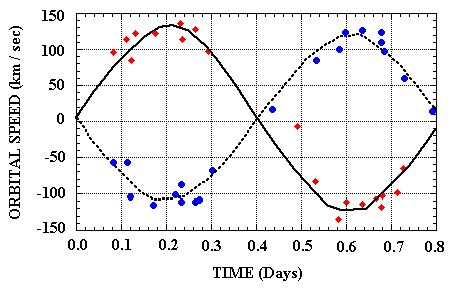
The actual measurements of both of Castor C's binary stars look
decidedly like the first graph, and demonstrate very strongly that
Einstein was right. At the binaries' relatively small speeds, the
differences in calculated velocities between classical and
Einsteinian Doppler shifts is insignificant - only a few miles per
hour out of hundreds of times the speed of sound.

June 2001 Meeting: Global
Warming
by Dave Thomas
At our Wednesday, June 13th, 2001 meeting, we heard Dr. David
Gutzler UNM Earth & Planetary Sciences, speaking on "Global
Warming: Science and Policy Perspectives." Prof. Gutzler discussed
greenhouse warming, the current status of climate change research,
and the Kyoto protocol.
Gutzler first described the Greenhouse Effect, wherein sunlight
emitted by the 6000oK-hot sun passes through earth's
transparent atmosphere, is absorbed by the ground, and is re-emitted
as infrared radiation, which heats up the air. Almost all the energy
emitted by the ground is absorbed by the atmosphere in one way or
another. Gutzler emphasized that the Greenhouse Effect is not a
"villain," if there were no Greenhouse Effect, the earth's
temperature would be 33oC (about 59oF) cooler
than it is today, making the average temperature a chilly
255oK (-18oC, or about 0 o F). What
absorbs the infrared radiation? Nitrogen and oxygen gases
(O2 and N2) are not good absorbers, so 99% of
the atmosphere is not involved. Trace gases, including water vapor
(H2O), carbon dioxide (CO2), nitrous oxide
(N2O), and methane (CH4) are the key players.
Ozone (O3) is a player only for incoming sunlight - it
absorbs the ultraviolet well, but doesn't react to the infrared
radiation emitted by the earth. Gutzler presented data showing that
CO2 levels are increasing, from a pre-industrial level of
280 ppmv to 315 ppmv (1958), and 355 ppmv (1988). There is no
plausible explanation for this increase besides people, Gutzler
said.
Temperatures have been rising also, but that gets more
complicated. In the last century, temperatures increased by
0.6oC. (See American Geophysical Union's
EOS, Vol. 80, No. 39, September 28, 1999, p. 453,
"Climate Change and Greenhouse Gases" by Tamara S. Ledley, et.
al., online at http://www.agu.org/eos_elec/99148e.html).
Gutzler noted that the :Little Ice Age" was a European phenomenon,
not a worldwide one. Temperature records, based on oxygen isotopes,
overlay beautifully with CO2 levels, but is temperature
responding to CO2, or is CO2, responding to
temperature? For example, when earth's orbit makes the seas colder
(the Milankovitch cycle), they absorb more CO2. The
Greenland ice-core record, going back 100 thousand years, shows that
the last ten thousand years have been very stable, the most stable in
the last thousand centuries. Gutzler said he is worried because "We
shouldn't mess with a good thing."
We do understand some things quite well, like the Greenhouse
Effect. We know that CO2 levels are increasing due to
humanity; global temperatures are increasing; and carbon dioxide and
temperature are intimately connected in paleoclimate studies. Why is
there any debate? One source of uncertainty is climate monitoring: we
need to improve our climate observation system, for both present and
past changes. Our knowledge of the global CO2 cycle is
incomplete -- what happens to CO2 emissions? Some of it
goes to the oceans, and some to vegetation on the land, but we don't
know if it will become saturated in either reservoir. We need better
understanding of particulate pollution, which in many cases, such as
sulfates, mitigates warming. We don't understand climate
feedbacks well enough. For example, if there are a lot of clouds,
sunlight will be reflected, cooling the earth, but more infrared will
be re-absorbed, heating the earth. If there are more glacial ice
sheets, that reflects more sunlight, cooling the earth, creating more
ice sheets; as ice sheets retreat, less sunlight is reflected,
heating the earth and melting more ice. As water vapor absorbs more
heat, the temperature rises, allowing more water vapor to form, which
absorbs more heat, and so forth. The situation is so complicated that
we need models to study it. Climate forecasts are incredibly
difficult, and we've never predicted anything as complicated as this
before. In older models, many state-sized parcels of air were used to
represent the atmosphere, but clouds are much smaller than states,
and could not be accurately analyzed. Newer models have the cell size
down to about a degree of latitude (70 miles or so), but are still
far larger than typical clouds. We can model some large scale
phenomena like the trade winds, but are still having trouble with El
Niño.
Prof. Gutzler concluded his talk with remarks on the Kyoto
accords. The International Panel on Climate Change, IPCC, didn't
issue any conclusion in their 1990 report. By 1995, they concluded
there was a discernible effect of humanity on the climate. In 2001,
they declared that most of the warming of the last 50 years is
human-caused. Critics of the Kyoto accords point to discrepancies
between various models as proof that they are all incorrect, but
Gutzler noted that it is impossible for different models to agree
exactly, and that we need humility in the face of so much
uncertainty. The Kyoto protocol was based on the Ozone Depletion
treaty of 1992. Its goals for "Annex I" (developed) countries include
reductions of greenhouse gas emissions to at least 5% below 1990
levels by 2008-2012, with progress by 2005, and credit for
CO2 sinks (forests, for example). Goals for the 38 Annex I
countries include 6% reductions in Japan and Canada, 7% in the USA,
and 8% in Europe. There are no goals for non-Annex I countries, and
that's one of the sticking points. Fully 55 countries, which include
55% of the emissions, must ratify the treaty before it can take
effect; so far, no Annex I countries have ratified the
treaty.
NMSR thanks Dave Gutzler for a very interesting talk.

May 2001 Meeting:
Self-Assembling Materials
by Dave Thomas
At our Wednesday, May 9th, 2001 meeting, we heard Dr. Jeff
Brinker, UNM Physics Department and Sandia National Laboratories,
speaking on "Self-assembled materials ... From Dishwashing to
Nanostructures." Brinker is helping try out a novel collaboration
between UNM and Sandia. So far, he said, it's produced some
interesting results.
Brinker's goals are not overly ambitious. He simply wants to learn
how to control matter on the nanometer scale, devising methods to
impart life-like qualities to materials -- such as sensing and
responding to their environments. Jeff also wants to learn how to
make a material that can repair, replicate, or propel itself. The
tricky part is doing this at nano-scales, anywhere from one to 100
nanometers (nm, billionths of a meter). [For comparison to
familiar units, a 1-mil (1/1000 inch) garbage bag is a whopping
25,400 nm wide; the wavelength of yellow light is about 500 nm.]
Brinker's experiments are on such small scales that he needs a
Transmission Electron Microscope just to see what's happening.
At such small scales, photolithography, the method used to produce
intricately detailed integrated circuits, is far too bulky and
clumsy. With the wavelength of light many times larger than the
desired work area, it's like trying to thread a needle with a rope.
Brinker was thus led to study methods in which materials assemble
themselves.
One remarkable self-organizing material is common dish detergent.
Brinker said detergents are "pre-programmed for self-assembly."
Detergents are mode of molecules that are hydrophilic (water-soluble)
on one end, and hydrophobic (attracted to oils, but repelled by
water) on the other end. When detergent is added to water, and energy
is added (in the form of splashing or stirring), the detergent
molecules naturally line up side-by-side on opposite sides of a thin
film of water, creating a new structure (the thin film). Jeff works
with silica mixtures; silica is abundant (sand), and silicic acid has
many of the properties he needs to exploit.
` Brinker showed a triangular "phase diagram" with water at the
lower left, a surfactant ("detergent") on top, and a hydrophobic
substance at the lower right corner. He often uses alcohol as the
hydrophobic material, and pluronic for the surfactant. Brinker brews
up a wicked broth of silica, alcohol and water, and lets it
evaporate. As the alcohol evolves, funny-looked studded spheres start
to form. As the ratio of ethanol to pluronic and water decreases, the
self-organizing reactions change, producing a succession of curious
shapes: spheres, then cylinders, then hexagonal pipes, then cubes,
and finally lamellar (sheeted) structures. This all happens within a
few seconds in the lab.
What good is this nano-tinkering? Well, different-sized
surfactants produce different-sized holes, and so this method can be
used to make hexagonal arrays of very tiny, very uniform holes - just
what is needed to make filters for specific molecules and gases. In
addition, material properties such as dielectric constant can be
altered; for example, Brinker's group can produce silica with half
the dielectric constant of the normal material, making it a better
insulator for integrated circuits and similar devices.
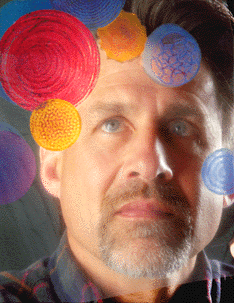 Jeff Brinker
Jeff Brinker
Jeff showed many fascinating images of the complex and detailed
structures his group and others have produced. Some of the structures
looked like the Russian dolls-within-dolls, while others resembled
sea-shells, with alternating layers creating strong materials.
Brinker's group is now looking at polymerizable surfactants,
something that leads to the possibilility of printing out exotic
nano-materials using a common inkjet printer.
NMSR thanks Jeff Brinker for a very interesting talk.

April 2001 Meeting:
Zero-Knowledge Proofs
by John Geohegan
In the April Meeting, Dr. Gustavus Simmons introduced us to the
significance and the mathematical basis of zero-knowledge proofs.
Professing little knowledge of the mathematics, what follows is my
understanding of the subject.
Since the time of Euclid some 2,300 years ago, the method of
convincing someone you could prove a mathematical theorem has been to
write out the proof and hand it to him. In the last 25 years,
however, there has been a major change; it is now possible to
convince someone that you have a proof in hand without giving him any
knowledge! The new technique is an outgrowth of public-key
cryptography which started in the 1970s. In 1986 Manuel Blum
published a very readable paper titled "How to Prove a Theorem So No
One Else Can Claim It", expanding on a paper the previous year by
Goldwasser, Micali, and Rackoff. Blum showed that it was possible to
devise a zero-knowledge proof for any provable theorem. Notice
there's difference between proving a theorem and persuading someone
else that you have the proof.
Writing in the Feb. 17, 1987, New York Times, James Gleick said
"Although zero-knowledge proof began as an abstraction, computer
scientists quickly realized its applicability to many everyday uses
of secrecy. The issue arises whenever someone tears up credit-card
carbons, looks over his shoulder while signing onto a computer or
worries about the photocopying of a passport left with a hotel
concierge."
Zero-knowledge proofs depend upon a series of interactions between
the prover and the verifier that are more and more persuasive as the
number of interactions increases, and upon the existence of a
mathematical procedure that's easy in the forward direction but very
difficult in reverse. In modular arithmetic it's easy to square a
number but very difficult to extract the square root. For an everyday
example, suppose I have a "smart card" that identifies me as knowing
the modular square root of a large number, perhaps 200 digits long.
In the blink of an eye, a verifying program could determine that I
truly know such a square root. The following "humanized" example
illustrates the verification process using smaller numbers.
Prover: "I know the square root of 1251, modulo
1517, and I'll prove it without telling you what it is. I also know
the square root of 247."
Verifier: "Prove to me you know the square root of
247."
Prover: "The square root of 247 is 42, modulo
1517.(This means that if 42 is squared, giving 1764, and divided by
1517, the remainder is 247. So 42 is called the square root of 247).
I also know the square root of 821."
Verifier: "I can multiply 1251 times 821 and get
1,027,071 which leaves a remainder of 62 when divided by 1517. Since
you claim to know the two square roots, you should be able to
multiply them together and give me a square root of 62. What is
it?"
Prover: "217 is a square root of 62. That means that
if I square 217 and get 47089, then divide by 1517 I'll get a
remainder of 62."
Verifier: "You're right, and I had no way of
computing the square root of 62 because I didn't know the square root
of either 1251 or 821. Let's do this a few more times and then I'll
be very certain that you're giving me perfect square numbers and that
you know the square root of 1251."
Explanation: The secret square root of 1251 is 94, and the square
root of 821 is 83. When the Verifier asked for the square root of 62,
the Prover multiplied 94 times 83, which leaves a remainder of 217
after dividing by 1517. For large numbers, it's easy to find a
modular square but practically impossible to find a modular square
root. A smart card can prove I know a large square root without
giving away any information.
The name of Gus Simmons is sprinkled liberally through the
literature of zero-knowledge proofs, validations, public-key
cryptography, and factoring of large numbers. After hearing him speak
I was inspired to come home and finally gain a rudimentary
understanding of both public-keys and zero-knowledge. Our thanks to
Bill Fienning and Dusty Cravens for promoting this most interesting
meeting, and to Gus Simmons for a stimulating talk
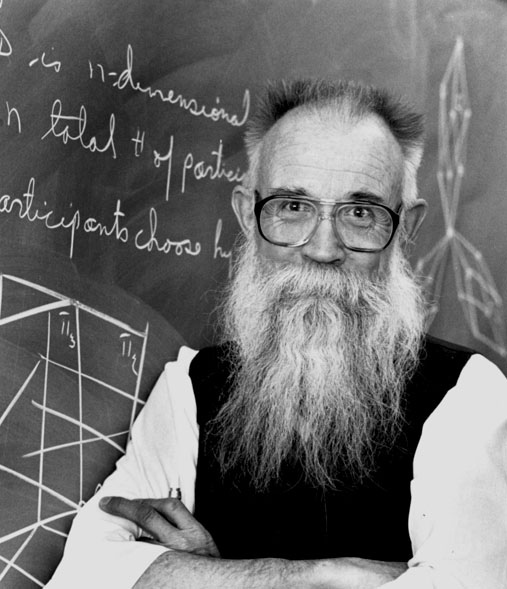 Gus Simmons
Gus Simmons

March 2001 Meeting: The
English Language and its Discontents
by Dave Thomas
New Mexicans for Science & Reason (NMSR) heard linguistics
Prof. Henry F. Beechhold, retired from the College of New Jersey,
Trenton, at our March 14th meeting. Beechhold's topic was "The
English Language and its Discontents." Hank began by saying that
"Nothing comes close to language in its complexity," and added that
computers with all their detailed circuits are not complicated
compared to language. Language is our most significant invention,
Beechhold said, but we don't yet know how it really works: "How is
language reproduced in the brain? How does a thought become a
sentence?"
Hank criticized "stupid definitions" like the one for a sentence
in grammar: "a subject and a predicate forming a complete thought" -
because, he asked, "What is a thought?" He emphasized the connections
between language and culture, and noted "The gadgets we invent
re-invent us." Beechhold discussed the subtle flavorings of language,
and explained how the word "is" can be more than just a factual
assertion. For example, "is" can be a value judgment: "He is
brilliant." "We look at the world through language-colored glasses,"
he said. Beechhold went on to discuss the fundamental interplay of
presence and absence, and how things are often defined by what they
are not: "Bush is no Clinton," for example.
Languages are unstable, just like humans, Beechhold said. Words
can be swapped between different languages, and this can happen at
different times, with curious "hodgepodge" results. Hank presented
the origins of the word "civilization," which began with the word
"hive," clearly related to an organized society. The "H" in Hive
gradually developed into a "K" sound, and "Hive" morphed into "Kiv,"
and eventually "Civis," (pronounced "Kivas"); with the later adoption
of the soft "C" sound, "kivas" changed into "civis," as in
civilization. In a second example, the "D" in "Dent" gradually
acquired a "T" sound, while the "T" in "denT" took on a "th" sound,
and so the word "DenT" can be seen as directly ancestral to a word
with the same meaning: "TooTH."
Beechold discussed the origins and evolution of the English
language, which has a common source with Germanic languages. He
emphasized the importance of context, and how context is required to
make sense of the words: is "fire" a noun? ("Put out the fire.") Or
is it a verb? ("Fire the scumbag.") Hank stated that a full grammar
is impossible, as is a complete dictionary. Language is too volatile,
and the only languages that don't change are extinct ones, such as
classical Latin. There are as many as 6000 languages, Beechhold said,
and each one is inherently ambiguous.
Hank was the pronunciation editor for a large scientific
encyclopedia, and had to choose the "proper" way for scientists to
pronounce many science-related words. If you've been saying
"kil-ó-me-ter," by the way, it's really "kíl-o-me-ter."
Who pronounces "míll-i-me-ter" as "mill-í-me-ter,"
after all?
Thanks to Hank Beechhold for a fascinating talk.
 Hank Beechhold
Hank Beechhold
ADDENDUM: NOVEMBER 8TH,
2002
Beechhold corrects NMSR
error...
Hank Beechhold takes issue with part of the summary of his last
NMSR talk (March 2001, April 2001 NMSR Reports), and has kindly
offered the following as a clarification.
The point I was making was based on Grimm's Law (aka, the First
Germanic Consonant Shift), a schema (developed by Jakob Grimm of the
Grimm Brothers) that shows how certain sounds in the Germanic
sub-family of the Indo-European (IE) family of languages deviated
from the other members of the Indo-European family. In this schema,
to use but one pair of the affected sounds, what appears in
non-Germanic IE languages, such as Latin (and many others) as a "k"
sound equates to an "h" sound in the Germanic languages (of which
English is a representative example). Thus, where we find in, say,
Latin a "k" sound (as in the root "civis-," pronounced "kee-wiss"),
we find in, say, English, an "h" sound, as in "hive." This is not
arbitrary, for there must be a semantic relationship between the
Latin root and the English word. We can see this relationship in the
BORROWED word, "civilization" (where the "k" sound, as it happens,
has been shifted, via French, to an "s" sound, but this is irrelevant
to the point). So our word, "hive," has a semantic relationship with
"civilization." This is important for, to repeat, we don't just
arbitrarily match sounds up. The match must occur where there is a
clear semantic connection. A beehive is, indeed, a "civilization" (as
it were) of bees. Another example of Grimm's correspondences is the
non-Germanic IE "and the Germanic "T," as illustrated with Latin
"dent" (in BORROWED words like "dental," "dentist," etc.) and the
English "t" (in English "tooth," exhibiting an obvious semantic
relationship to the Latin root). In fact "tooth" shows two of Grimm's
correspondences, the d/t pair and the t/th pair. A full explanation
of the process that the sound-shift schema represents would take a
good deal more discussion than you have space for in the newsletter,
and no one but linguistics types would have the patience to follow
it! To clarify a question that may arise: diachronic linguists (of
which I am one) distinguish between linguistic elements that derive
from a parent source - in this case Proto-Indo-European - and those
that are simply borrowed at a much later time. English has been
particularly free about borrowing, and was pushed hurriedly along
this path in the aftermath of the Norman conquest (1066 and all
that), although the borrowing actually started much earlier. After
the advent of the Normans in England, the Norman brand of French
(itself a form of Latin) insinuated itself into English in a big way.
This, too, is an overly simple thumbnail view; it would take an
entire course (which I gave) to unravel it properly.
- Hank Beechhold

January 2001
Meeting: Faster than Light???
by Dave Thomas
New Mexicans for Science & Reason (NMSR) heard Dr. Mohammed
Mojahedi, UNM Physics Department, speaking on "Superluminal
Velocities and Einstein Causality" at our January 10th meeting.
Before the meeting got started, reporter John Fleck was called up
to receive NMSR's first-ever "Honorary Electron" award, in honor of
his excellent expositions of neat science stories in the Albuquerque
Journal.
Dr. Mojahedi works at the University of New Mexico's Center for
High Tech Materials (CHTM) near University and César
Chávez. His group has done a fascinating experiment, reported
in the October 2000 issue of "Physical Review E," in which pulses
have been measured as traveling faster than the speed of light in
vacuum, some 300 million meters per second.
Dr. Mojahedi described the background of the work, starting with
Maxwell's development of the theory of electromagnetic waves, and
Hertz's confirmation of their existence. Einstein's special theory of
relativity said that the laws of physics were the same in all
inertial reference frames, and that the speed of light in vacuum was
constant in all inertial frames; Einstein also showed that matter
could not be accelerated to exceed the speed of light. Sommerfeld and
Brillouin analyzed several different kinds of "velocity," including
phase velocity, group velocity, energy velocity, Sommerfeld signal
velocity, and the velocities of Sommerfeld and Brillouin "forerunner"
signals. There are many ways to define velocity, and Mojahedi
wondered which ones were subject to Einstein's laws.
In Mojahedi's experiment, a beam of microwaves was split into two,
and the path lengths for the two beams calibrated. Then, a special
array of plastic window panes was inserted into one of the beams. One
might expect that the array of windows might slow down the pulse,
delaying the arrival of that beam. But, just the opposite happened.
Mojahedi's group consistently measured the window-path beam's main
pulse as arriving half of a billionth of a second before the pulse
from the vacuum-path beam; for the small distances involved on the
lab table, this amounted to a speed of 2.38c - over twice the speed
of light!
The effect is due to quantum tunneling effects in the window
materials, dielectric photonic crystals. Mojahedi exploited a curious
property called "Evanescent Mode Propagation" to achieve his
surprising results.
But, how surprising were the results? Was Einstein causality
violated? Mojahedi said "No." The faster-than-light-speed
("superluminal") propagation was observed only for the main part of
the pulse signal. This is the large-amplitude part of the pulse that
is easy to measure. It's much harder to measure the very beginning of
the signal - the "forerunner" or "precursor" - because those signals
have very small amplitudes. Yet, the forerunner signals are the ones
that obey the cosmic speed limit of the universe, the speed of
light.
Mojahedi used an analogy involving race cars. The forerunner
signals correspond to the sharp front edge of the race cars, while
the main section of the race cars, containing the driver, correspond
to the main pulse of the signals. In both the "normal" and
"superluminal" paths, the forerunner signals arrive at the same time
- both travel at the speed of light, no faster. (See points labeled A
and A' on the diagrams below). However, the main pulse is accelerated
in the photonic crystals, with the result that it arrives earlier in
the superluminal path (going through the special windows) than
through the vacuum path. (See points labeled B And B' on the diagrams
below).
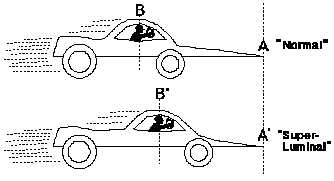
The figure below shows signals like the ones Mojahedi's group
measured. The Sommerfeld forerunner signals arrive at the same time
for both the normal path (A, top) and "superluminal" path (A',
bottom). The Brillouin forerunners arrive next, with the superluminal
path's signal winning that race by a small amount. The main envelope
of the superluminal pulse arrives earlier (B') than the envelope for
the normal pulse (B). And so the velocity of the forerunner pulse
does not exceed that of light, but the "group velocity" (for the main
pulse envelope) does.
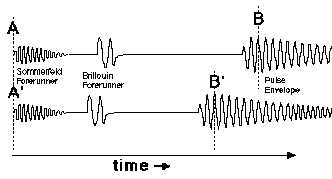
Mojahedi described how his work challenges some of the earlier
thinking in this field, such as comments by Borne and Wolfe, and
Brillouin, that superluminal group velocities had no physical
significance or meaning. Does this work suggest that
faster-than-light communications might be possible? Unfortunately,
no. While the superluminal pulse (B') might arrive before its vacuum
counterpart (B), it will never precede the arrival of its precursor
(A'). That would be like the driver of the race car reaching a point
before the leading edge of the car does. However, the work may hold
promise for speeding up detection of pulses in applications such as
computing.
Thanks to Dr. Mojahedi for a delightful talk.

NMSR Site
Map












 Trish Henning
Trish Henning
 Biologist Randy Thornhill
Biologist Randy Thornhill Linguistics professor Hank Beechhold
Linguistics professor Hank Beechhold




 Jeff Brinker
Jeff Brinker Gus Simmons
Gus Simmons

